Home » Posts tagged 'banks' (Page 5)
Tag Archives: banks
European Banks Reveal Scale & Complexity of Crisis. Shares Hammered Back to 1987 Level
European Banks Reveal Scale & Complexity of Crisis. Shares Hammered Back to 1987 Level
They haven’t gotten over Financial Crisis 1 and the Euro Debt Crisis. Now there’s a new crisis. Deutsche Bank’s CEO going on TV to soothe nerves didn’t help matters.
The biggest European banks have started to report their earnings against a bleak backdrop of locked down economies, plunging economic activity, surging business closures and rising loan defaults. Each earnings call laid bare the scale, scope and complexity of the problems and challenges facing a European banking sector that never really recovered from their last two crises — the Global Financial Crisis followed by the Euro Debt Crisis.
The Stoxx 600 Banks index, which covers major European banks, fell 4.5% on Thursday. Today, continental European stock markets were closed (May Day), but the London Stock Exchange was open, and the index ticked down another 1% (to 88.8). The Stoxx 600 Banks index has already collapsed by 40% since Feb 17, when the Coronavirus began spreading through northern Italy. After the initial 40%-plus plunge in late February and early March, the index has remained in the same dismally low range:
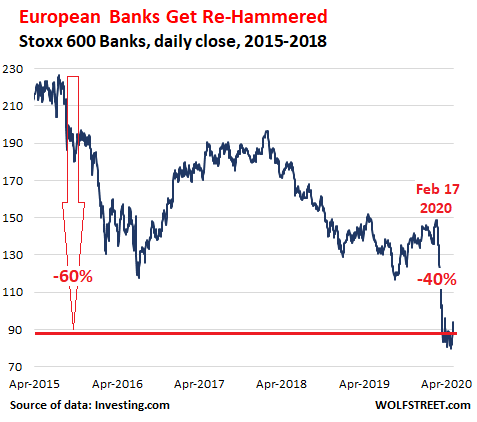
On April 21, the Stoxx 600 Banks Index had closed at 79.8, down 83% since its peak in May 2007, and the lowest since 1987. The following day, the ECB announced it was going to accept junk bonds as collateral when banks borrow from it. Yesterday, the ECB was excepted to go even further and announce that it would actually buy junk-rated bonds, as the Federal Reserve announced a few weeks ago. But the ECB didn’t announce it, and the Fed hasn’t bought any junk bonds yet either.
…click on the above link to read the rest of the article…
Banks Will Not Bail Out The Economy
Banks Will Not Bail Out The Economy
These days, we hear a lot that banks were the problem in the 2008 crisis and now they are the part of the solution.
Banking was not the main problem of the 2008 crisis, but one of the symptoms that indicated a more serious disease, the excess risk taken by public and private economic agents after massive interest rate cuts and direct incentives to take more debt coming from legislation as well as local and supranational regulation. Lehman Brothers was not a cause, it was a consequence of years of legislation and monetary policies that encouraged risk-taking.
The second part of the sentence, “now banks are the solution,” is dangerous. It starts from a wrong premise, that banks are stronger than ever and can bail out the global economy. Banking may be part of the solution, but we cannot place, as the eurozone is doing, the entire burden of the crisis on the banks’ balance sheet. I will explain why.
When economists in Europe talk endlessly about the differences in growth and success of monetary and fiscal policy between the United States and Europe, many ignore two key factors. In the United States, according to the St Louis Federal Reserve, less than 15% of the real economy is financed through the banking channel, in the European Union, it is almost 80%. In addition, in the United States, there is an open, diversified, more efficient and faster mechanism to clean non-performing loans and recapitalize the economy that adds to its high diversification in private non-bank financing channels.
It is, therefore, essential that in periods of crisis countries, particularly in Europe, do not relax risk analysis mechanisms, because the economic recovery may be slowed down by ongoing problems in the financial sector and even lead to a banking crisis in the midterm. The worst measure that countries can take in a crisis is to force incentives to take a disproportionate risk.
…click on the above link to read the rest of the article…
FDIC asks Americans to keep their money in the banks
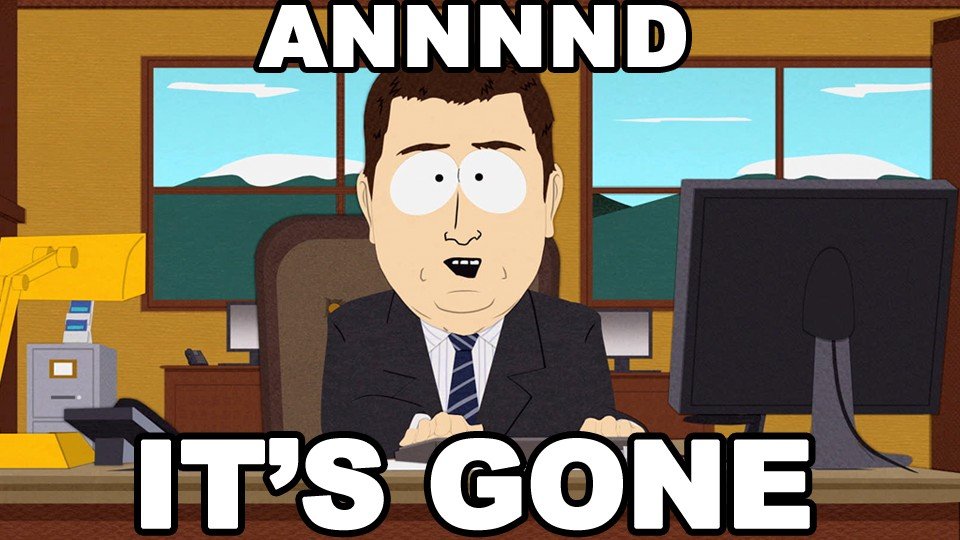
FDIC asks Americans to keep their money in the banks
Yesterday the Chair of the FDIC released an astonishing video asking Americans to keep their money in the bank.
Accompanied by soft piano music playing in the background, the official said:
“Your money is safe at the banks. The last thing you should be doing is pulling your money out of the banks thinking it’s going to be safer somewhere else.”
Amazing. I was half expecting her to waive her hand and say, “These aren’t the droids you’re looking for…”
As I’ve written before, there’s $250 TRILLION worth of debt in the world right now: student debt, housing debt, credit card debt, government debt, corporate debt, etc.
And let’s be honest, some of that debt is simply not going to be paid.
Millions of people have already lost their jobs. Millions more (like the 10 million waiters and bartenders across America) are barely earning anything right now because their businesses are closed.
A lot of those folks have no emergency savings to fall back on during times of crisis, so they’re going to be forced to choose: pay the rent, or buy food.
The government has already suspended evictions and foreclosures, which is a green light for people to stop paying the rent or mortgage.
And that means banks will take it in the teeth.
This is what happened back in 2008– millions of people across the country stopped paying their mortgages, and the banking system nearly collapsed as a result.
Today it’s a similar situation; a lot of people are going to stop paying their mortgages, credit cards, auto loans, etc. And that directly impacts the banks.
…click on the above link to read the rest of the article…
Banks are going to drown in an ocean of defaults
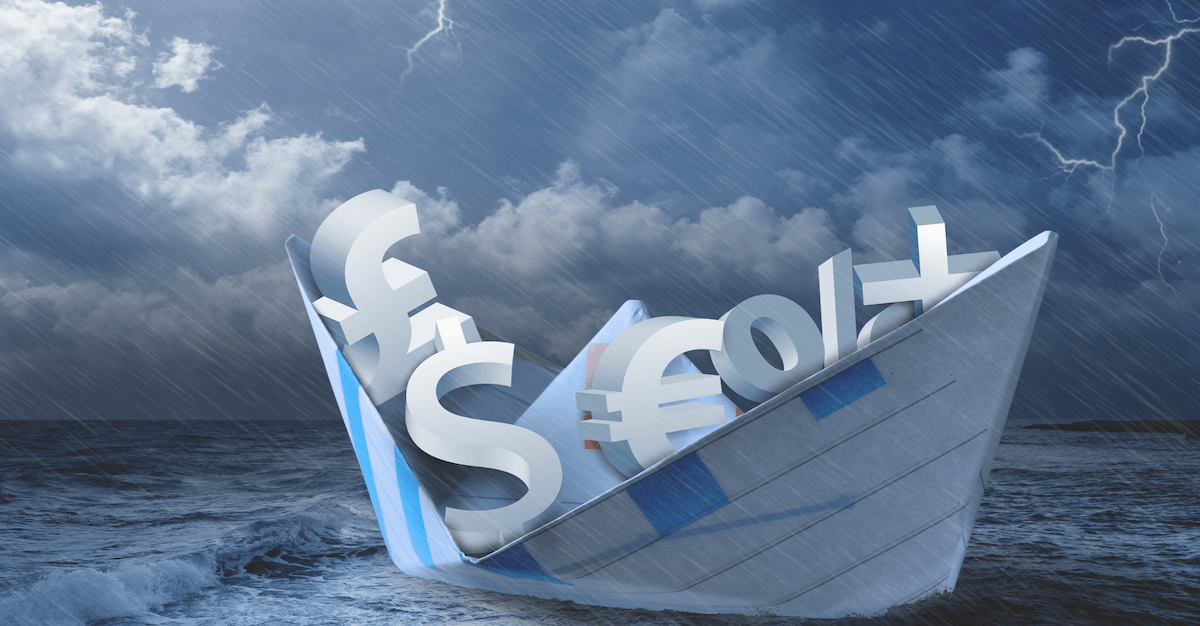
Banks are going to drown in an ocean of defaults
On November 6, 2000, then US presidential candidate George W. Bush told a crowd of cheering supporters, “they misunderestimated me.”
Now, if English is not your native language, allow me to clear the air: ‘misunderestimate’ is not a word. But then again, George W. Bush was legendary for hilarious slip-ups like this.
There are entire books dedicated to his ‘Bushisms,’ the ridiculous made-up words and incomprehensible sayings that became routine for the 43rd US President.
‘Misunderestimate’ seems to be a conflation of the words ‘misunderstand’ and ‘underestimate’. And while that was utterly hysterical 20 years ago when Bush first said it, ‘misunderestimate’ may be the most appropriate word of today.
The entire world has completely ‘misunderestimated’ the Corona Virus.
In terms of misunderstand– that’s obvious. There’s so much that we don’t know about the virus (officially known as SARS-CoV-2) and the disease that it causes (COVID-19).
For example, a group of researchers published a “peer-reviewed” research paper earlier this month stating that the virus had split into multiple strains.
(Peer-reviewed is a type of self-regulation among academics; it means the paper had been evaluated by other experts before it was published.)
But other specialists in the field strongly disagreed with the paper’s conclusions.
Swiss biologist Richard Neher described the research as, “wrong, misleading. . . downright dangerous inferences,” while Australian virologist Ian Mackay called it a “weak paper and poor science.”
Another peer-reviewed study released in the Journal of Medical Virology concluded that the virus originated from snakes. But plenty of experts disagreed with that assertion too.
The scientific community has learned so much about SARS-CoV-2 since it first surfaced a few months ago.
…click on the above link to read the rest of the article…
America Is The 4th Worst Abuser Of Biometric Privacy Rights In The World
America Is The 4th Worst Abuser Of Biometric Privacy Rights In The World
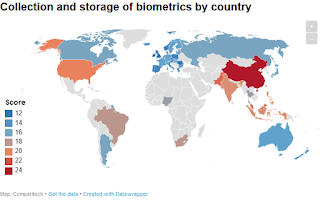
Does anyone really believe America is still the land of the free?
Since 9/11, DHS, the FBI, the CIA, and countless other alphabet soup agencies have turned the United States into a public surveillance monstrosity.
In 19 years, one terrorist attack has done what no one else could have dreamed of: turn America’s freedoms into a distant memory.
Abusing citizen’s rights and privacy used to be the hallmark of dictatorships and police states like the CCCP or North Korea.
A recent study conducted by Comparitech, rated 50 countries from best to worst at protecting citizen’s biometric data.
The study found that America is one of the world’s worst abusers of citizen’s biometric privacy.
“While China topping the list perhaps doesn’t come as too much of a surprise, residents of (and travelers to) other countries may be surprised and concerned at the extent of biometric information that is being collected on them and what is happening to it afterward.”
This really should not come as a surprise, because last year Comparitech revealed that American and Chinese cities lead the world in spying on their citizens. Last week, I wrote an article explaining how 2019 would go down as the year that facial recognition and corporate surveillance became commonplace in America.
Comparitech’s recent study on biometric privacy compared how 50 countries collect and use data to identify innocent people:
- Many countries collect travelers’ biometric data, often through visas or biometric checks at airports
- Every country we studied is using biometrics for bank accounts, e.g. fingerprints to access online app data and/or to confirm identities within the banks themselves
- Despite many countries recognizing biometric data as sensitive, increased biometric use is widely accepted
- Facial recognition CCTV is being implemented in a large number of countries, or at least being tested
…click on the above link to read the rest of the article…
Farewell to Paper Money?
Farewell to Paper Money?

A decade or more ago, I began to discuss with associates the possibility of governments and banks colluding to eliminate physical cash. Back then, the idea struck most everyone as poppycock, that governments could never get away with it.
I didn’t write on the subject until 2015, when several countries had begun to limit the amount of money a depositor could extract from his bank account. At that point, the prospect that central banks might conceivably eliminate cash was looking less like an alarmist fantasy, and it became possible to write on the nascent issue.
In a nutshell, today, in most of the world’s most prominent countries, the people who control banking are the same people who pull the strings in government. A cashless system therefore seemed to me to be a natural, as it dramatically increased both profit and power for both banking and government – an opportunity that can’t be passed up.
The Benefit to Banking
Some banks have been delving into negative interest rates, which is a euphemism for charging you to keep your money in the bank, so that they can loan it out for their own profit. You actually lose money annually by having it on deposit.
Of course, some people accept negative interest rates in order to retain the imagined safety of having their cash in a bank vault, rather than at home. Others tolerate it because they value the convenience of using ATMs and chequing.
But anyone else may simply decide to store their money at home and save the “reverse interest” charges.
But what if cash were eliminated? No one would have a choice. They’d have to have a bank account and use it for all transactions, or they couldn’t purchase goods or pay bills.
…click on the above link to read the rest of the article…
China Braces For December D-Day: The “Unprecedented” Default Of A Massive State-Owned Enterprise
China Braces For December D-Day: The “Unprecedented” Default Of A Massive State-Owned Enterprise
Something is seriously starting to break in China’s financial system.
Three days after we described the self-destructive doom loop that is tearing apart China’s smaller banks, where a second bank run took place in just two weeks – an unprecedented event for a country where until earlier this year not a single bank was allowed to fail publicly and has now had no less than five bank high profile nationalizations/bailouts/runs so far this year – the Chinese bond market is bracing itself for an unprecedented shock: a major, Fortune 500 Chinese commodity trader is poised to become the biggest and highest profile state-owned enterprise to default in the dollar bond market in over two decades.
In what Bloomberg dubbed the latest sign that Beijing is more willing to allow failures in the politically sensitive SOE sector – either that, or China is simply no longer able to control the spillovers from its cracking $40 trillion financial system – commodity trader Tewoo Group – the largest state-owned enterprise in China’s Tianjin province – has offered an “unprecedented” debt restructuring plan that entails deep losses for investors or a swap for new bonds with significantly lower returns.
Tewoo Group is a SOE conglomerate, owned by the local government and operates in a number of industries including infrastructure, logistics, mining, autos and ports, according to its website. It also operates in multiples countries including the U.S., Germany, Japan and Singapore. The company ranked 132 in 2018’s Fortune Global 500 list, higher than many other Chinese conglomerates including service carrier China Telecommunications and financial titan Citic Group. Even more notable are the company’s financials: it had an annual revenue of $66.6 billion, profits of about $122 million, assets worth $38.3 billion, and more than 17,000 employees as of 2017, according to Fortune’s website.
…click on the above link to read the rest of the article…
Is the Fed Secretly Bailing Out a Major Bank?
Is the Fed Secretly Bailing Out a Major Bank?
Prettifying Toxic Waste
The promise of something for nothing is always an enticing proposition. Who doesn’t want roses without thorns, rainbows without rain, and salvation without repentance? So, too, who doesn’t want a few extra basis points of yield above the 10-year Treasury note at no added risk?

Thus, smart fellows go after it; pursuing financial innovation with unyielding devotion. The underlying philosophy, as we understand it, is that if risk is spread thin enough it magically disappears. In other words, the solution to pollution is dilution.
With this objective, new financial products are fabricated into existence. The risk free rewards of several extra basis points are then packaged up into debt instruments and sold off to pension funds and institutional investors. The search for yield demands it.
Yet as an economic expansion progresses, especially one that has been extended and distorted with the Fed’s cheap credit, these derived financial securities are polluted with more and more toxic waste. Spreading the risk ultimately pollutes the entire pool of liquidity.
At this moment in the business cycle, after a lengthy bull market in stocks and bonds, countless manifestations of the greater fool theory have bubbled up to the surface. Bonds with negative yields epitomize this. Buyers accept a guaranteed coupon loss with the hopes of scoring capital appreciation as yields fall. But when yields rise, it is game over.
German Bund futures contract, weekly. The recent blow-off and subsequent reversal illustrates the convexity effect on bond prices… [PT]
Of course, the greater fool theory extends much deeper and wider than negative yielding debt. It also extends to the polluted world of corporate debt…
…click on the above link to read the rest of the article…
The Federal Reserve Is Directly Monetizing US Debt
The Federal Reserve Is Directly Monetizing US Debt
In a very real way, MMT is already here
Sure, it’s not admitting to this. And it’s using several technical jinks and jives to offer a pretense that things are otherwise.
But it’s not terribly difficult to predict what’s going to happen next: the Federal Reserve will drop the secrecy and start buying US debt openly.
At a time, mind you, when US fiscal deficits are exploding and foreign buyers are heading for the exits.
How It’s Supposed to Work
Here’s how it’s supposed to work when the US government issues new debt:
- If the US Treasury needs to raise new funds, it announces an upcoming auction of US Treasury bills/notes/bonds.
- A date for the auction is set.
- Various participants bid for those bills/notes/bonds (including ‘regular folks’ like you and me if we’re using the government’s Treasury Direct program).
- At a later date, the Fed can buy those US Treasury bills/notes/bonds. The various holders of that debt submit offers to sell, and the Fed (presumably) selects the best offers on the best terms.
The Federal Reserve, under no conditions, buys Treasury paper directly. The Federal Reserve’s own website still maintains that this is the case:

There are two important claims plus one assertion I’ve highlighted in there, each in a different color:
- Yellow: Treasury securities may “only be bought and sold in the open market.”
- Blue: doing otherwise might compromise the independence of the Fed.
- Purple: the Fed mostly buys “old” securities.
So according to the Fed: it’s independent, it follows the rules set forth in the Federal Reserve Act of 1913, and it mostly buys “old” Treasury paper that the market has already properly priced in a free and fair system.
But that’s not really what’s going on…
…click on the above link to read the rest of the article…
Global Debt Is Up To $188,000,000,000,000 – This Is Officially The Biggest Debt Bubble The World Has Ever Seen
Global Debt Is Up To $188,000,000,000,000 – This Is Officially The Biggest Debt Bubble The World Has Ever Seen
The world is now 188 trillion dollars in debt, and that number continues to grow rapidly each year. It is a form of enslavement that is deeply insidious, because most of those living on the planet do not even understand how the system works, and even if they did most of them would have absolutely no hope of ever getting free from it. The borrower is the servant of the lender, and the global financial system is designed to funnel as much wealth to the top 0.1% as possible. Of course throughout human history there has always been slavery, and the primary motivation for having slaves is to extract an economic benefit from those that are enslaved. And even though most of us don’t like to think of ourselves as “slaves” today, the truth is that the global elite are extracting more wealth from all of us than ever before. So much of our labor is going to make them wealthy, and yet most people don’t even realize what is happening.
Let’s start with a very simple example to help illustrate this.
When you go into credit card debt and you only make small payments each month, you can easily end up paying back more than double the amount of money that you originally borrowed.
So where does all that money go?
Well, of course it goes to the financial institution that you got your credit card from, and in turn that financial institution is owned by the global elite.
In essence, you willingly became a debt slave when you chose to go into credit card debt, and the hard work that it took to earn enough money to pay back that debt with interest ended up enriching others.
…click on the above link to read the rest of the article…
The monetary lessons from Germany
The monetary lessons from Germany
Germany suffered two currency collapses in the last century, in 1920-23 and1945-48. The architect of the recovery from the former, Hjalmar Schacht, chose to cooperate with the Nazi successors to the Weimar Republic, and failed. In that of the second, Ludwig Erhard remained true to his free market credentials and succeeded. While they were in different circumstances, comparisons between the two events might give some guidance to politicians faced with similar destructions of their state currencies, which is a growing possibility.
Introduction
Let us assume the next credit crisis is on its way. Given enhanced levels of government debt, it is likely to be more serious than the last one in 2008. Let us also note that it is happening despite the supposed stimulus of low and negative interest rates, when we would expect them to be at their maximum in the credit cycle, and that some $17 trillion of bonds are negative yielding, an unnatural distortion of markets. Let us further assume that McKinsey in their annual banking survey of 2019 are correct when they effectively say that 60% of the world’s banks are consuming their capital before a credit crisis. Add to this a developing recession in Germany that will almost certainly lead to both Deutsche Bank and Commerzbank having to be rescued by the German government. And note the IMF recently warned that $19 trillion in corporate debt is a systemic timebomb, and that collateralised loan obligations and direct exposure to junk held by the US commercial banks is approximately equal to the sum of their equity.
Then we can say with some confidence that a major credit crisis is developing, and that it will almost certainly be far greater than Lehman.
…click on the above link to read the rest of the article…
Half The World’s Banks Won’t Survive The Next Crisis, McKinsey Finds
Half The World’s Banks Won’t Survive The Next Crisis, McKinsey Finds
More than half of the world’s banks are at risk of collapse in the next global downturn if they don’t start preparing for late-cycle shocks, McKinsey & Company warned in its latest global banking outlook.
The consultancy firm warned on Monday, in a 55-page report titled The last pit stop? Time for bold late-cycle moves, that 35% of banks globally are “subscale” and will have to merge or sell to larger firms if they want to survive the next crisis.
“A decade on from the global financial crisis, signs that the banking industry has entered the late phase of the economic cycle are clear: growth in volumes and top-line revenues is slowing, with loan growth of just 4% in 2018—the lowest in the past five years and a good 150 basis points (bps) below nominal GDP growth. Yield curves are also flattening. And, although valuations fluctuate, investor confidence in banks is weakening once again,” McKinsey said.
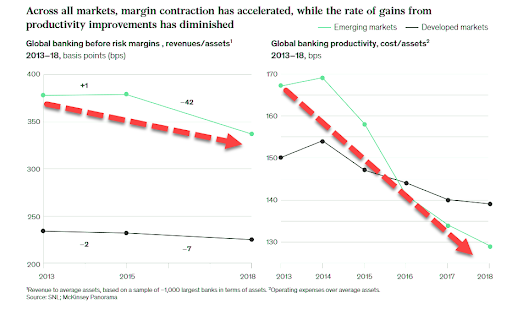
Kausik Rajgopal, a senior partner at McKinsey, told Bloomberg that “we believe we’re in the late economic cycle and banks need to make bold moves now because they are not in great shape,” adding that, “in the late cycle, nobody can afford to rest on their laurels.”
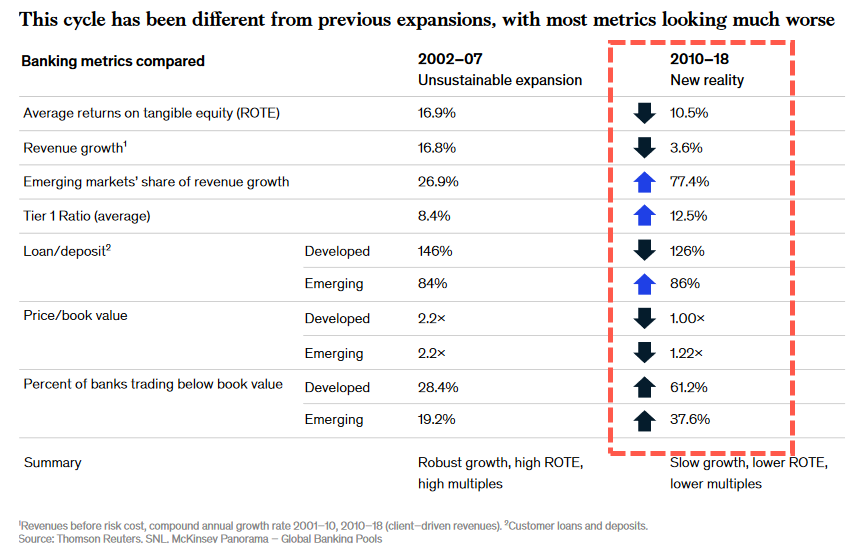
The report warned that 60% of global banks are experiencing “returns below the cost of equity.” And even warned that when the next recession strikes, “negative interest rates could wreak further havoc.”
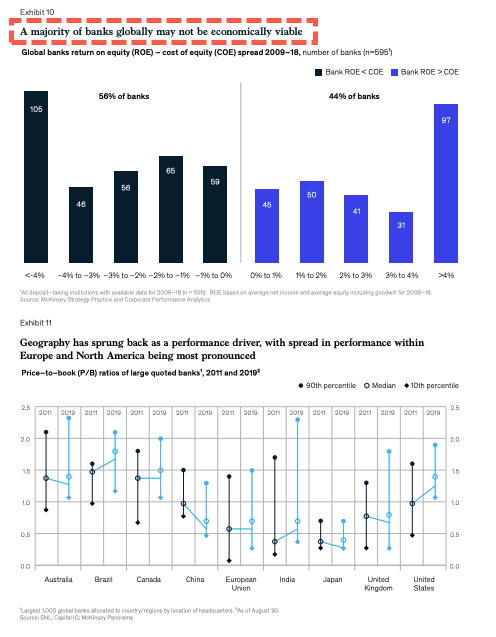
McKinsey said fin-tech startups are rapidly evolving the industry, and legacy banks risk “becoming footnotes to history” if they don’t immediately invest in technology. For instance, the report said, Amazon and Ping An are two technology firms that are quickly acquiring market share from the traditional banking sector.
Underestimating Them & Overestimating Us
UNDERESTIMATING THEM & OVERESTIMATING US
“Do not underestimate the ‘power of underestimation’. They can’t stop you, if they don’t see you coming.” ― Izey Victoria Odiase

During the summer of 2008 I was writing articles a few times per week predicting an economic catastrophe and a banking crisis. When the biggest financial crisis since the Great Depression swept across the world, resulting in double digit unemployment, a 50% stock market crash in a matter of months, millions of home foreclosures, and the virtual insolvency of the criminal Wall Street banks, my predictions were vindicated. I was pretty smug and sure the start of this Fourth Turning would follow the path of the last Crisis, with a Greater Depression, economic disaster and war.
In the summer of 2008, the national debt stood at $9.4 trillion, which amounted to 65% of GDP. Total credit market debt peaked at $54 trillion. Consumer debt peaked at $2.7 trillion. Mortgage debt crested at $14.8 trillion. The Federal Reserve balance sheet had been static at or below $900 billion for years.
During 2007, a risk averse senior citizen couple (my parents) who had accumulated $200,000 of retirement savings over their lifetime of hard work, could generate $10,000 of interest income in a Vanguard money market fund yielding 5%. This supplemented their modest Social Security income of $20,000 to $30,000 per year. The interest rate on savings during normal economic times was generally 2% above inflation, which hovered around 3% in 2007 according to the data manipulators at the BLS.
As the summer of 2008 progressed, I felt more disconnected. I had been doing everything possible to support Ron Paul’s candidacy for president, but the masses weren’t ready for the truth or the reality of our situation. In my opinion the country was already off-course and headed towards a debt created disaster.
…click on the above link to read the rest of the article…
GOLDNOMICS PODCAST: Prepare Now As Risk Of Contagion In Today’s Fragile Monetary World
GOLDNOMICS PODCAST: Prepare Now As Risk Of Contagion In Today’s Fragile Monetary World
◆ GOLDNOMICS PODCAST – Episode 13 – Lucky for some !
◆ Why is nobody talking about the real risk of contagion to investors, savers & companies?
◆ While all the focus in the UK, Ireland and the EU is on Brexit, the risk of another debt crisis looms as companies, banks, governments and the global economy grapple with massive levels of debt
◆ “Contagion will impact stocks, bonds and deposits and both investments and savings across the spectrum”
◆ Prepare for the 4 C’s: i) Counter party risk ii) Credit and debt crisis iii) Currency wars and iv) Contagion
◆ Complex financial & technology systems in the fintech age make the counter parties which investors and savers rely on more fragile. This highlights the need for direct and outright legal ownership of tangible assets
◆ Financial, economic and monetary contagion risk underlines the importance of real diversification and owning gold in the safest ways possible
We Finally Understand How Destructive Negative Interest Rates Actually Are
We Finally Understand How Destructive Negative Interest Rates Actually Are
We are in the midst of a strange economic experiment. Vast quantities of negative-yielding debt are currently sloshing around the global economy. While the amount of negative-yielding bonds has dropped recently from a mind-boggling number in excess of $17 trillion, reinvigorated central bank easing across the globe ensures that this reduction is only temporary.
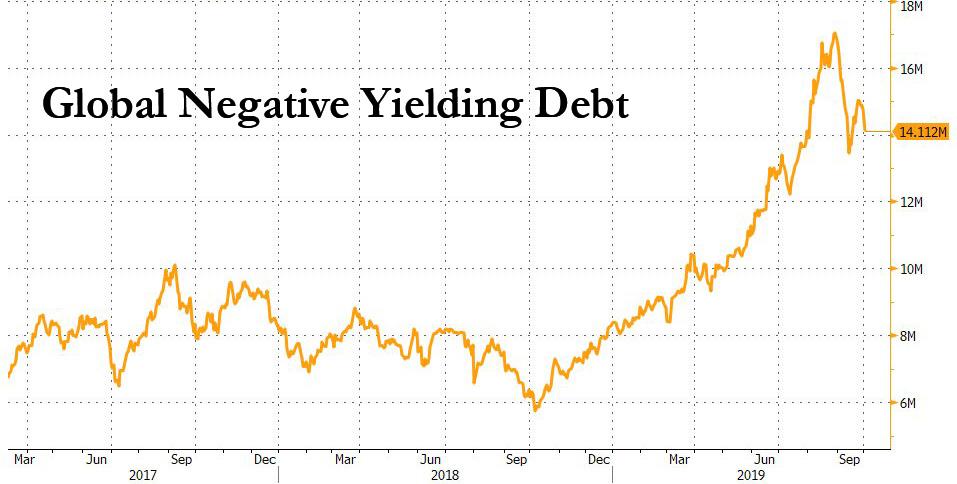
We are slowly starting to understand how destructive negative interest rates actually are. Central banks control short-term interest rates in an economy by setting the rate banks receive on their deposits, that is, on the reserves they hold at the central bank. A new development is the control central banks now exert over long-term rates through their asset purchase, or “QE” programs.
Banks profit from the interest rate differential between “lending long” but “borrowing short”. Essentially, the difference between lending and deposit rates determine a bank’s profitability. However, with today’s very low interest rates, this difference becomes almost non-existent, and with negative rates, inverts completely.
When a central bank pushes rates to negative, banks need to pay interest on the reserves they hold there. But they are not relieved of the obligation they have to pay interest on customer deposits, who are understandably reluctant to pay interest on money they place at a bank. Consequently, the whole earnings logic of banking goes haywire if banks are required to pay interest on loans and receive interest on deposits. As profit margins of banks are squeezed, profitability falls and lending activities suffer.
However, the problems created by negative interest rates do not stop there. In 2008, an influential article describing the economic malaise in Japan after the financial crash of the early 1990s found that instead of calling-in or refusing to refinance existing debts, large Japanese banks kept loans flowing to otherwise insolvent borrowers.
…click on the above link to read the rest of the article…





